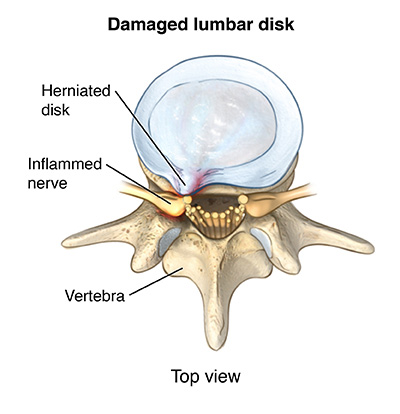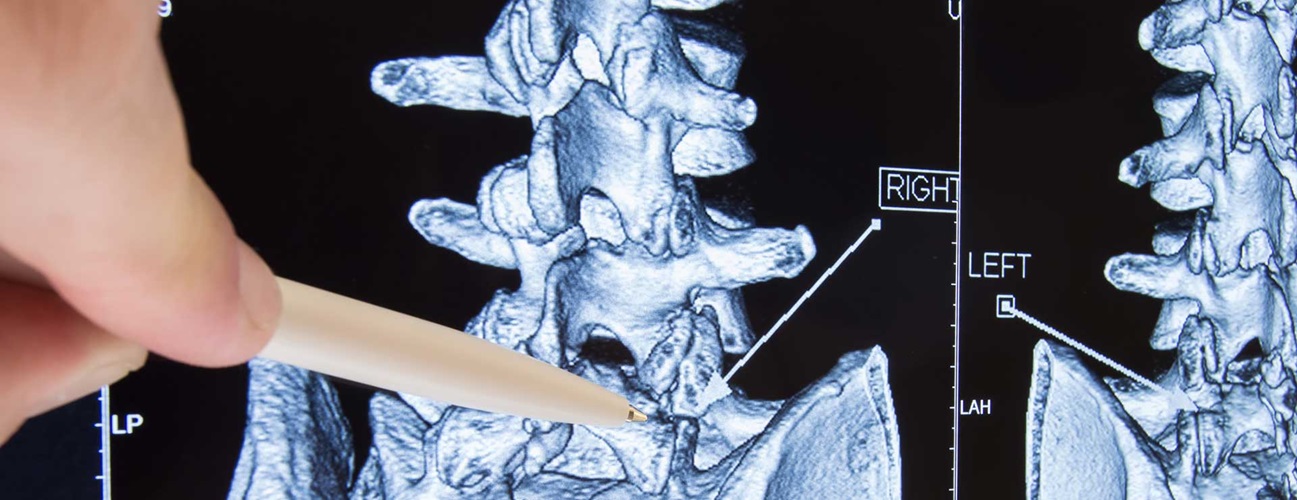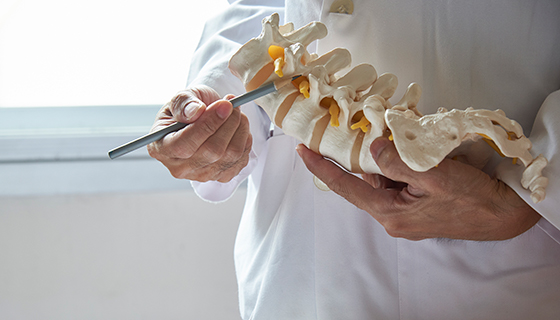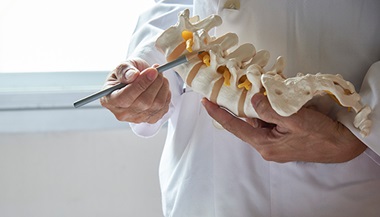Radiculopathy
What You Need to Know
- Radiculopathy describes a range of symptoms produced by the pinching of a nerve root in the spinal column.
- The pinched nerve can occur at different areas along the spine (cervical, thoracic or lumbar).
- Symptoms of radiculopathy vary by location but frequently include pain, weakness, numbness and tingling.
- A common cause of radiculopathy is narrowing of the space where nerve roots exit the spine, which can be a result of stenosis, bone spurs, disc herniation or other conditions.
- Radiculopathy symptoms can often be managed with nonsurgical treatments, but minimally invasive surgery can also help some patients.
What is radiculopathy?
Your spine is made of many bones called vertebrae, and your spinal cord runs through a canal in the center of these bones. Nerve roots split from the cord and travel between the vertebrae into various areas of your body. When these nerve roots become pinched or damaged, the resulting symptoms are called radiculopathy.
Types of Radiculopathy
Radiculopathy can have different symptoms and different names depending on where in the spine it occurs.
Lumbar Radiculopathy
When radiculopathy occurs in the lower back, it is known as lumbar radiculopathy, also referred to as sciatica because nerve roots that make up the sciatic nerve are often involved. The lower back is the area most frequently affected by radiculopathy.
Radiculopathy Prevention
While radiculopathy can’t always be prevented, staying physically fit and maintaining a healthy weight may reduce your risk of radiculopathy. Using best practices for good posture while sitting, playing sports, exercising or lifting heavy objects is also important for preventing injuries.
Cervical Radiculopathy
Cervical radiculopathy describes a compressed nerve root in the neck (cervical spine). Because the nerve roots in this area of the spine primarily control sensations in your arms and hands, this is where the symptoms are most likely to occur.
Thoracic Radiculopathy
Thoracic radiculopathy refers to a compressed nerve root in the thoracic area of the spine, which is your upper back. This is the least common location for radiculopathy. The symptoms often follow a dermatomal distribution, and can cause pain and numbness that wraps around to the front of your body.
Symptoms of Radiculopathy
When a nerve root is compressed, it becomes inflamed. This results in several unpleasant symptoms that may include:
-
Sharp pain in the back, arms, legs or shoulders that may worsen with certain activities, even something as simple as coughing or sneezing
-
Weakness or loss of reflexes in the arms or legs
-
Numbness of the skin, “pins and needles,” or other abnormal sensations (paresthesia) in the arms or legs
Your specific symptoms will depend on where in the spine the nerve root is pinched. However, it’s also possible that you don’t experience any symptoms or you go through periodic flare-ups of symptoms.
Causes of Radiculopathy
Radiculopathy is typically caused by changes in the tissues surrounding the nerve roots. These tissues include bones of the spinal vertebrae, tendons and intervertebral discs. When these tissues shift or change in size, they may narrow the spaces where the nerve roots travel inside the spine or exit the spine; these openings are called foramina. The narrowing of foramina is known as foraminal stenosis, which is very similar to spinal stenosis that affects the spinal cord.
In most cases, foraminal stenosis is caused by gradual degeneration of the spine that happens as you age. But it can also be a result of a spinal injury.
Herniated Discs
One common cause of foraminal stenosis and radiculopathy is a bulging or herniated disc. Spinal discs act as cushions between your vertebrae. On occasion, these discs slip out of place or become damaged and press on nerves. This problem is most likely to occur in your lower back, but it can also affect your neck.

Bone Spurs
Another possible cause of radiculopathy that may lead to narrowing of foramina is bone spurs — areas of extra bone growth. Bone spurs can form in the spine due to inflammation from osteoarthritis, trauma or other degenerative conditions.
Other Causes
Thickening (ossification) of the spinal ligaments may also lead to narrowing of the space around the nerve roots and subsequent nerve compression. Less common causes of radiculopathy include spinal infections and various cancerous and noncancerous growths in the spine that may press against the nerve roots.
Radiculopathy and Myelopathy
Sometimes, radiculopathy can be accompanied by myelopathy — compression of the spinal cord itself. Herniated or bulging discs can sometimes press on the spinal cord and on the nerve roots. When the spinal cord is involved, the symptoms can be more severe, including poor coordination, trouble walking and paralysis.
Radiculopathy Versus Neuropathy
Radiculopathy symptoms may overlap with those of peripheral neuropathy, making it difficult to pinpoint the source of the problem. Peripheral neuropathy is the damage of the peripheral nervous system, such as carpal tunnel syndrome that involves trapped nerves in the wrist. Radiculopathy is the pinching of the nerves at the root, which sometimes can also produce pain, weakness and numbness in the wrist and hand. Consult a spine specialist for an accurate diagnosis.
Radiculopathy Diagnosis
Your doctor may take several steps to diagnose radiculopathy:
-
A physical exam and physical tests may be used to check your muscle strength and reflexes. If you have pain with certain movements, this may help your doctor identify the affected nerve root.
-
Imaging tests, such as an X-ray, CT scan or MRI scan, are used to better see the structures in the problem area.
-
Nerve conduction studies, along with electromyography, can also be used to help pinpoint whether the problem is neurological or muscular.
Radiculopathy Treatment
Radiculopathy treatment will depend on the location and the cause of the condition as well as many other factors. Nonsurgical treatment is typically recommended first and may include:
-
Medications, like nonsteroidal anti-inflammatory drugs, opioid medicines or muscle relaxants, to manage the symptoms
-
Weight loss strategies to reduce pressure on the problem area
-
Physical therapy to strengthen the muscles and prevent further damage
-
Steroid injections to reduce inflammation and relieve pain
Some people may need more advanced treatments, such as surgery. Surgery is typically used to reduce the pressure on the nerve root by widening the space where the nerve roots exit the spine. This may involve removing all or parts of a disc and/or vertebrae. Cervical posterior foraminotomy is one of the minimally invasive spine surgery options available.






